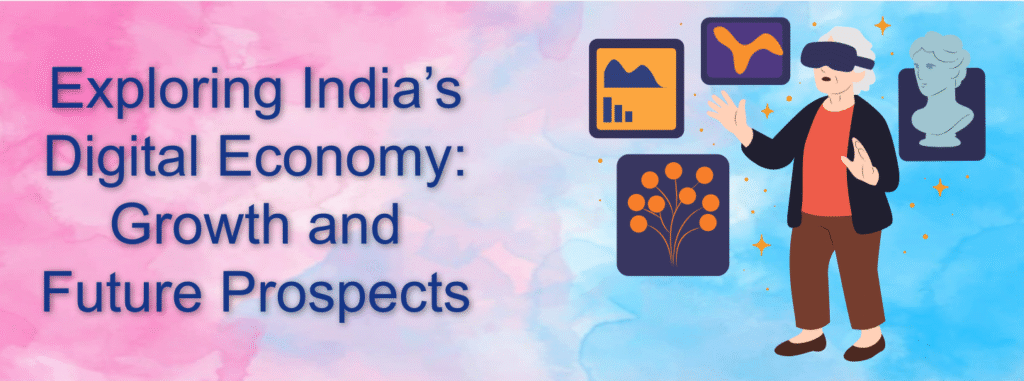Exploring India’s Digital Economy: Growth and Future Prospects

India, the world’s largest democracy and home to over 1.4 billion people, is undergoing a massive digital transformation. Over the past decade, the country has emerged as a global leader in digital innovation, driven by a tech-savvy population, affordable internet access, and visionary government initiatives like Digital India.
In 2025, India’s digital economy stands as a cornerstone of national development, influencing everything from financial inclusion and healthcare to education and e-commerce. This article explores the growth, opportunities, challenges, and the future of India’s thriving digital ecosystem.
The Rise of India’s Digital Economy
Key Stats (as of 2025):
- Valued at over $1.5 trillion
- Contributes approximately 18% to India’s GDP
- Over 850 million internet users
- Nearly 90% mobile internet penetration
The growth is driven by a combination of:
- Affordable smartphones
- Low-cost mobile data
- UPI-based digital payments
- Startups and innovation hubs
- Strong policy support from the government
Major Government Initiatives
1. Digital India Mission
Launched in 2015, this flagship initiative aims to:
- Digitize governance and public services
- Improve digital literacy
- Expand broadband connectivity across rural India
Key programs under Digital India include:
- BharatNet (for rural broadband)
- DigiLocker (cloud storage of government documents)
- UMANG App (access to over 1000+ public services)
2. India Stack
India Stack is a set of APIs and digital public infrastructure that powers the digital economy:
- Aadhaar: Unique biometric ID
- e-KYC: Paperless verification
- UPI: Instant digital payments
- DigiLocker: Document verification and sharing
This stack is unique to India and enables massive scalability and inclusion.
3. ONDC (Open Network for Digital Commerce)
ONDC aims to democratize e-commerce by allowing buyers and sellers to transact on open networks, bypassing monopolies.
Key Sectors Driving the Digital Economy
1. Fintech
India is now the global leader in real-time digital payments, thanks to UPI.
Other fintech verticals include:
- Peer-to-peer lending platforms
- Robo-advisory investment services
- Insurtech and regtech innovations
2. E-commerce
With ONDC and mobile-first consumers:
- Tier II and Tier III cities are seeing explosive growth.
- D2C (Direct-to-Consumer) brands are booming.
- Logistics tech startups are optimizing last-mile delivery.
3. EdTech
Companies like BYJU’S, Unacademy, and Vedantu have transformed how students learn. Now, AI-based adaptive learning and regional language content are the new focus.
4. HealthTech
Telemedicine, wearable health devices, and e-pharmacies are part of India’s digital healthcare revolution.
5. AgriTech
Startups are helping farmers access:
- Real-time weather updates
- Market prices
- Crop advisory via smartphone apps
6. Remote Work and SaaS
India’s talent pool powers global SaaS platforms, remote tech support, and productivity tools.
Opportunities and Growth Potential
- Global Digital Services Hub: India is expected to become the “back office of the world” for digital transformation.
- Startup Ecosystem: With over 100,000 startups, India is the third-largest startup ecosystem globally.
- Digital Exports: From IT services to gaming and software, digital exports are projected to cross $300 billion by 2030.
- AI and Emerging Tech: Government-backed centers of excellence are promoting AI, blockchain, IoT, and quantum computing.
Challenges in India’s Digital Economy
Despite strong momentum, several hurdles remain:
1. Digital Divide
- Rural internet speeds are still slow and unreliable.
- Only about 25% of rural households have access to a stable broadband connection.
- Digital literacy varies significantly by region and age.
2. Cybersecurity and Data Privacy
- Rising cases of data leaks and online fraud.
- India still awaits a robust data protection law akin to GDPR.
3. Regulatory Bottlenecks
- Unclear taxation policies for digital goods and services
- Ongoing debates around cryptocurrency and digital asset regulation
4. Digital Infrastructure
- Power outages and inconsistent 4G/5G rollout affect service delivery in remote areas.
India’s Role in the Global Digital Economy
India is not just consuming digital tech—it’s creating and exporting it.
Key Contributions:
- Exporting SaaS solutions to the US, EU, and ASEAN markets
- Becoming a BPO and ITES powerhouse
- Building digital public goods that other nations are replicating (e.g., Aadhaar, UPI)
India’s digital diplomacy is also growing. The country is helping African and South Asian countries build digital identity and governance platforms.
The Future of India’s Digital Economy
What to Expect by 2030:
- Digital economy contribution to GDP: Expected to exceed 25%
- India’s digital population: Over 1 billion active users
- Digital public infrastructure: Becoming a template for global adoption
- AI-led automation: Transforming industries like agriculture, healthcare, and logistics
India’s digital economy is a vehicle for inclusive growth, social mobility, and global competitiveness.
Final Thoughts
India’s digital economy is not just about technology—it’s about empowering people, connecting villages to cities, and giving everyone a voice in the global conversation.
With continued investment in infrastructure, education, and innovation, India is on track to become a digital superpower. As challenges are met with reforms and resilience, the digital economy will remain a key driver of India’s 21st-century growth story.
USEFUL LINKS:
https://awaraj.com/ai-powered-seo-revolutionizing-digital-marketing-in-2025/?utm_source=chatgpt.com

